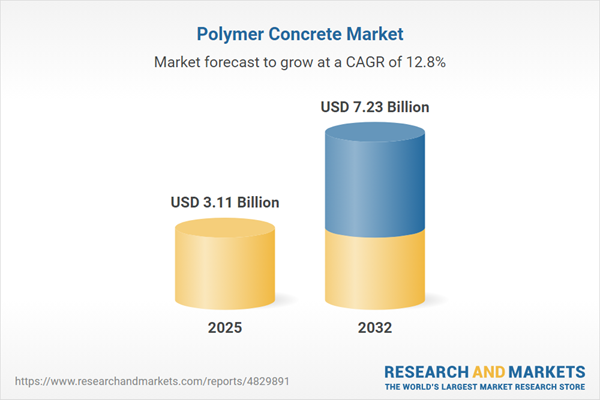Speak directly to the analyst to clarify any post sales queries you may have.
Senior decision-makers increasingly turn to the polymer concrete market for resilient and sustainable building solutions in complex infrastructure environments. This overview equips leaders with targeted insights, supporting confident adoption of advanced construction materials and technologies.
Market Snapshot: Polymer Concrete Market Growth and Dynamics
The polymer concrete market expanded from USD 2.75 billion in 2024 to USD 3.11 billion in 2025 and is forecasted to achieve USD 7.23 billion by 2032, representing a CAGR of 12.83%. Growth is fueled by progress in resin chemistry, regulatory focus on sustainability, shifts in infrastructure funding, and higher adoption of green building materials. Businesses proactively align with these sector dynamics to anticipate requirements and capitalize on transformation across value chains.
Scope & Segmentation
This comprehensive analysis enables long-term strategic planning for sector stakeholders by mapping the polymer concrete market across multiple dimensions. Segmentation reflects breadth in product types, application areas, end-use profiles, company activity, geographic spread, and technology adoption.
- Resin Types: Epoxy, isophthalic polyester, orthophthalic polyester, bisphenol vinyl ester, and novolac vinyl ester are evaluated for mechanical and chemical performance, allowing tailored applications in construction and renovation projects.
- Application Areas: Includes flooring systems for commercial, industrial, and decorative use; precast products suitable for rapid deployment in infrastructure; primers and sealers enhancing surface durability; and asset repair or rehabilitation solutions supporting long-term reliability.
- End Uses: Targets commercial, industrial, and residential construction segments, addressing new projects, upgrades, and ongoing maintenance needs in diverse environments.
- Regional Coverage: Analysis covers the Americas, Europe, Middle East & Africa, and Asia-Pacific. Market intelligence highlights strategic differences by region, such as compliance requirements, urbanization patterns, and procurement practices. Key countries include the United States, Germany, China, India, Saudi Arabia, South Africa, and Australia.
- Company Analysis: Profiles leaders such as Sika AG, BASF SE, MAPEI S.p.A., Fosroc International Limited, RPM International Inc., GCP Applied Technologies Inc., LATICRETE International, Inc., Chryso SA, Pidilite Industries Limited, and XYPEX Chemical Corporation, with emphasis on supply chain models and innovation initiatives.
- Technological Advancement: Focuses on emerging resin chemistries for enhanced lifecycle value, digital modeling for optimized material mixes, adoption of modular production, and R&D efforts to reduce environmental impact and support closed-loop supply chains.
Key Takeaways for Decision-Makers
- Polymer concrete is increasingly selected for infrastructure exposed to corrosive and high-stress environments, due to its reliable performance and durability over traditional materials.
- Leading suppliers are strengthening local manufacturing and pursuing vertical integration, aiming to bolster supply chain resilience and streamline costs across procurement channels.
- Implementation of digital tools in production and logistics is providing immediate transparency, enabling smarter inventory controls and predictive project coordination.
- Growing sustainability targets promote the use of recycled and bio-based resins, with organizations gaining measurable benefits in both operational efficiency and lifecycle outcomes.
- Companies adjust strategies according to regional compliance demands and urbanization trends, particularly within European and Asia-Pacific markets, adapting processes to optimize growth and mitigate risk.
Tariff Impact
Recent changes in United States tariffs impacting imported polymer resins and specialty aggregates are driving a shift in sourcing and cost management strategies. Industry leaders are enhancing domestic procurement, reworking contract terms, and exploring new mix alternatives to navigate market volatility. Diversified sourcing, risk-sharing models, and greater use of recycled or bio-based resin inputs are emerging as best practices, ensuring supply stability and continuous client value delivery.
Methodology & Data Sources
This report is based on interviews with executive-level, technical, and project leadership, and integrates findings from procurement and field performance surveys. Additional insights derive from technical literature, regulatory filings, and company financial statements, all validated through triangulation and rigorous statistical checks to uphold accuracy and decision-ready confidence.
Why This Polymer Concrete Market Report Matters
- Delivers data-driven strategies by tracking developments in resin technology, major regional hubs, and competitor actions across the global construction landscape.
- Enables proactive leadership by analyzing the effects of regulatory changes, tariff fluctuations, and digital adoption on supply chains and procurement approaches.
- Supports effective R&D prioritization and trusted partnerships, empowering stakeholders to meet client needs while adapting to sector disruptions.
Stakeholders receive actionable direction for realigning supply chains, evaluating technology investments, and driving forward value-centered initiatives.
Conclusion
As innovation, sustainability imperatives, and evolving regional requirements shape the polymer concrete market, decision-makers supplied with accurate market intelligence are better positioned to achieve growth and realize their business objectives.
Additional Product Information:
- Purchase of this report includes 1 year online access with quarterly updates.
- This report can be updated on request. Please contact our Customer Experience team using the Ask a Question widget on our website.
Table of Contents
3. Executive Summary
4. Market Overview
7. Cumulative Impact of Artificial Intelligence 2025
List of Figures
Samples

LOADING...
Companies Mentioned
The key companies profiled in this Polymer Concrete market report include:- Sika AG
- BASF SE
- MAPEI S.p.A.
- Fosroc International Limited
- RPM International Inc.
- GCP Applied Technologies Inc.
- LATICRETE International, Inc.
- Chryso SA
- Pidilite Industries Limited
- XYPEX Chemical Corporation
Table Information
| Report Attribute | Details |
|---|---|
| No. of Pages | 186 |
| Published | October 2025 |
| Forecast Period | 2025 - 2032 |
| Estimated Market Value ( USD | $ 3.11 Billion |
| Forecasted Market Value ( USD | $ 7.23 Billion |
| Compound Annual Growth Rate | 12.8% |
| Regions Covered | Global |
| No. of Companies Mentioned | 11 |









